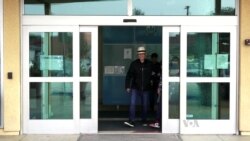Refugees from the genocide in Cambodia lost their country when they fled the Khmer Rouge regime 40 years ago. Now settled in the U.S., many Cambodian-Americans are afraid of also losing their culture.
“When I was growing up I had the same questions of identity that most immigrant children have: ‘Who am I? What am I? Am I Cambodian? Am I American? What am I?’” asked Nielson Sophann Hul, who left Cambodia when he was a baby.
The answer to these questions of identity for Hul was learning Khmer, the language of Cambodia.
“It allowed me to feel Khmer. It gave me a connection back to who I was. ... Without a proper understanding of the language, you cannot have a proper understanding of the culture,” said Hul, who now teaches Khmer and English at Long Beach City College.
Free classes
That is also one of the main reasons why the City of Long Beach started a free weekend Khmer class for adults and children eight years ago at its Mark Twain Neighborhood Library. Bryant Ben volunteers his time to oversee this program.
“…[To] keep your culture alive and to have your identity of who you are, and of course we’re here [in the U.S.], and we’re going to lose [language/culture] but at least we try to keep it as long as we can,” said Ben, adding, “[If] you know the language, you know the culture. Any language, any culture. Anything that you know is better than nothing.”
Henry Ouk has been taking his American-born son, Daniel, to Khmer class for the last three years.
“I want him to know his nationality so that he won’t forget his parents’ culture, as well as his own,” Ouk explained.
Eleven-year-old Daniel Ouk says his dad does make him come to class, but he appreciates it. “I wanted to learn about the language so I could understand my dad.”
Thirteen-year-old Satya Weir started coming to class two months ago.
“I am half Cambodian and my mom’s Cambodian, and so she thought that would be a great thing for me to do because when I went to Cambodia over the summer, I loved the culture and everything, and I thought we should learn [Khmer],” Weir said.
Passing it on
Traveling to Cambodia showed Weir that language and culture are intertwined.
“I want to carry on my culture and I want pass it onto my children so that they can learn Khmer and then I hope that they can do the same from generation to generation because it’s really important to be bilingual. And the Cambodian culture is pretty awesome, I think,” Weir said.
While there is demand for this class, resources in the community are limited. It’s been a challenge finding teachers because they are all volunteers. Hul is trying to find sponsors to help with the textbooks and supplies, so these classes can continue for as long as the need is there.
“You can’t forget about this community-based approach to language teaching and really, ultimately, the goal is to teach language or to have functionally fluent Khmer speakers and increase the overall number of literate Khmer,” Hul said.
“It’s for the Cambodian children, to know about their culture and tradition. He [my son] needs to know that Khmers have a country as well,” Ouk said.








